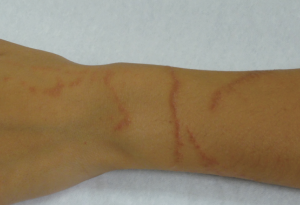Chapter 12: Skin Problems Caused by the Environment
Bites and Stings: Sea-jelly stings
Sea-jelly stings
Sea-jellies contain stinging cell that fire on contact with other animals. The stinging mechanism (nematocyst) is at the end of the tentacle and contact with the tentacle causes pain, redness and blistering in skin. Treatment is with removal of any attached tentacles, rinsing with sea-water and soaking in 5% acetic acid to prevent further firing of the nematocyst. Larvae of sea jellies can also become trapped under swim clothing and fire into the skin leading to sea bather’s eruption. Rapid removal of clothing followed by rinsing can help minimize symptoms. Rinsing with fresh water or towelling vigorously can worsen them.


